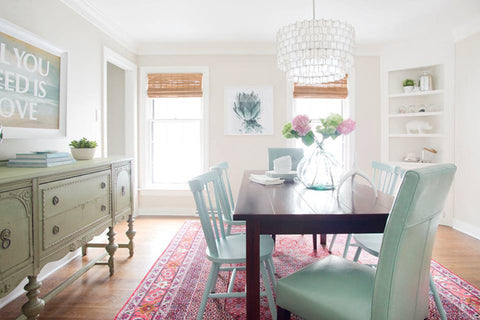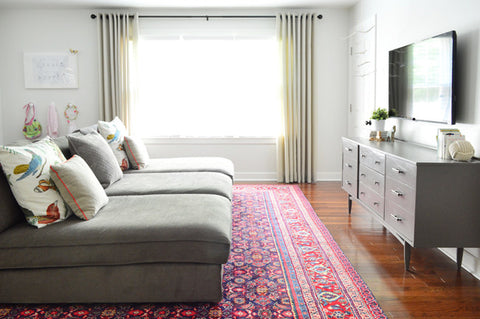Your Cart is Empty
Free Shipping For All Orders
Free Shipping For All Orders

YOUR RUG SHOPPING GUIDE: WHAT TO LOOK FOR, MISTAKES TO AVOID
June 14, 2017 6 min read
CHOOSING A RUG SIZE
We like big rugs and we cannot lie. That’s because generally speaking: the bigger the better when it comes to rugs. You obviously don’t want anything that hits the baseboards because it’s too oversized, but a nice generously-sized rug can make a room feel expansive and welcoming (while a rug that's too small can make a space feel smaller and choppier). In most cases, you can almost go wall-to-wall with your rug – just leaving a foot or two of border around each edge. For example, this 10 x 14″ green rug fills our 13.5 x 18″ bedroom nicely, adds some softness and pattern, and generally makes the room feel more polished and complete.
But in large rooms or open-concept spaces, a rug that big might be impractical for the space (or your wallet) – so the other way to determine size is to make sure your rug serves to “connect” the furniture in the room while helping you define a functional area. For instance, theliving room in our showhouse opened to the kitchen, so we usedthis 9 x 12″ rug to help define the seating area, making sure the couch, chair, and tables all felt connected to it and grounded by it. In an open floor plan, large area rugs can be the key to visually delineating different zones and helping the furniture to feel like it’s planted in a certain area, instead of floating listlessly in a large space.
CHOOSING A RUG DESIGN
While we’ve used plenty of solid-colored rugs in the past, we have learned over time that we generally like rugs with a pattern. Patterns can obviously add some visual interest to a room, but we also love that they hide wear well (and the cookie crumbs and paper clippings that happen to come along with two kids and a dog).
For instance, over the past few years we’ve hunted down three large traditional Persian and Turkish rugs for three high-traffic areas in our house (our living room, bonus room, and dining room). Why? Because the intricate patterns and deep colors are incredibly forgiving, and we also find them visually interesting and pretty.
In short: they’re like the jackpot of rugs for us.
Although you might worry their color and pattern would be too demanding, they almost act as a neutral in our house, just due to the fact that they can layer in almost anywhere. In fact, we’re sure we could swap out this bonus room rug for the one in our bedroom and it would work just as well in there. Just be aware of using them right next to a heavily patterned sofa or curtains.
Much like figuring out your favorite wardrobe staples (mine would be black everything, big earrings, and BLAZERS!!!), figuring out the rugs you love most can be awesome – especially if they work well for your family and your lifestyle. So if you realize that there’s a certain type of rug design and tone that’s forgiving for your family/lifestyle/crumb situation…. go for it!
Second to our love of traditional rugs, are smaller-scale geometric patterned ones (for similar wear-hiding reasons). The tighter or more varied the pattern, the better it will be at disguising crumbs or whatever else lurks in your rugs. For instance, in our first and second kitchens we had light-colored subtly patterned rugs, which both started to look dingy and dirty over time, just from random cooking splatters or dusty footprints. They were also pretty cheap/low quality, which didn’t help either. Meanwhile, the kitchen runner that we have now is still neutral, but it has a high-contrast diamond pattern that’s a lot tighter in scale (which is definitely more forgiving) and it’s made from higher-quality sisal, which can be hosed off and dried outside in the sun. But more on materials in a minute.
Whether we’re shopping for a traditional or geometrical pattern, we typically aim for an all-over, repeating pattern that’s small-to-medium in scale (nothing with a big medallion in the center or a giant high-contrast repeating design). We’ve owned a rug with alarge, asymmetrical graphic across it before, but typically find those harder to work with because they can become too visually demanding and may be harder to orient furniture around. Plus, the design may be less timeless than a more classic pattern. By comparison, we’ve hadthis lower-contrast trellis inspired rug for over five years without any signs of tiring of it.
But with all of the pattern and color options out there, it can still be tough landing on the right one for your space. Our favorite trick is to gather photos of your favorite options – whether it’s pics that you snap in the store or ones that you find online – and then scroll through them on your phone; quickly at first and then again more slowly. You can even pin them all to a Pinterest board and look at them collectively.
We find that we often notice things in pictures that we sometimes miss in person – like the way two options have similar borders, or how one seems much duller than the others, or how the scale of one feels a little off. These distinctions or similarities might highlight a sometimes subconscious preference for a certain design, or eliminate an option that stands out in a bad way. So the photo trick is always our go-to way to double-check a rug decision.
CHOOSING A RUG MATERIAL
We prefer to purchase 100% natural material rugs – like thick 100% wool rugs (so plush!) or 100% cotton flat weaves (plus rug pad!). We also like natural fiber rugs, like the sisal runner in our kitchen (which is backed with rubber to keep it from slipping around). Basically, we try to avoid rugs that are a mix of multiple materials – like 90% one fiber, and 10% another. Why? We’ve had them and they just haven’t held up as well (we’ve had various issues with fading, staining, and sometimes even unravelling). We've read many articles about rug materials and a mixture of fibers is usually a sign they’re made from lower quality materials (like olefin, acrylic, polypropeline, etc) which may not feel as nice underfoot and may not wear as well over time. Those options can be good budget-saving choices, but unless we need an indoor/outdoor rug, we try to stick to natural materials these days.
Our preference for natural materials is two-fold. The first reason is the overall feel of the rug: wool is so plush, cotton is soft (and can even be machine washable in some cases) and even the right jute can feel nice underfoot (our kitchen runner isn’t scratchy at all).
The second is durability and longevity. These materials are made for the long haul (in fact our three wool Persian and Turkish rugs are antiques, so they have been around for decades and are still going strong!) and their fibers are also great for keeping clean. I’m probably jinxing myself for saying this, but we haven’t had a single stain that we couldn’t remove from a wool, cotton, or jute rug in our house (including a Sharpie mark! More on that below). It’s why we don’t sweat having our most expensive wool rug in a food-heavy room like the dining room, where wayward meatballs are abound.
RUG CLEANING & CARE
The way we maintain and clean our cotton and wool is pretty much the same. We vacuum them regularly, and in the case that we’ve spilled something, we just spot clean with a ton of water (dabbing to lift the water along with whatever has spilled). And if we need to we’ll reach for some very mild soap like Dr. Bronners or Mrs. Meyers. So far – *knock on wood* – this has removed every single type of stain (marinara sauce, wine, jelly, you name it!). And of course if it’s just our sisal runner in the kitchen we’ve been known to shake it outside, hose down any spots on it, and just let it air dry in the sun out there before bringing it back in. So easy.
I’ve also successfully used a stain-lifting Tide pen on this rug after a certain marker incident that shall not be retold. I was shocked, but it looks just as good as when we bought it. The mark came right out!
This article published in younghouselove.com
Subscribe
Sign up to get the latest on sales, new releases and more …



